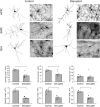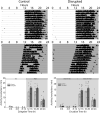Early life circadian rhythm disruption in mice alters brain and behavior in adulthood
- PMID: 35513413
- PMCID: PMC9072337
- DOI: 10.1038/s41598-022-11335-0
Early life circadian rhythm disruption in mice alters brain and behavior in adulthood
Abstract
Healthy sleep supports robust development of the brain and behavior. Modern society presents a host of challenges that can impair and disrupt critical circadian rhythms that reinforce optimal physiological functioning, including the proper timing and consolidation of sleep. While the acute effects of inadequate sleep and disrupted circadian rhythms are being defined, the adverse developmental consequences of disrupted sleep and circadian rhythms are understudied. Here, we exposed mice to disrupting light-dark cycles from birth until weaning and demonstrate that such exposure has adverse impacts on brain and behavior as adults. Mice that experience early-life circadian disruption exhibit more anxiety-like behavior in the elevated plus maze, poorer spatial memory in the Morris Water Maze, and impaired working memory in a delayed match-to-sample task. Additionally, neuron morphology in the amygdala, hippocampus and prefrontal cortex is adversely impacted. Pyramidal cells in these areas had smaller dendritic fields, and pyramidal cells in the prefrontal cortex and hippocampus also exhibited diminished branching orders. Disrupted mice were also hyperactive as adults, but otherwise exhibited no alteration in adult circadian locomotor rhythms. These results highlight that circadian disruption early in life may have long lasting and far-reaching consequences for the development of behavior and the brain.
© 2022. The Author(s).
Conflict of interest statement
The authors declare no competing interests.
Figures






Similar articles
-
Disruption of circadian clocks has ramifications for metabolism, brain, and behavior.Proc Natl Acad Sci U S A. 2011 Jan 25;108(4):1657-62. doi: 10.1073/pnas.1018375108. Epub 2011 Jan 10. Proc Natl Acad Sci U S A. 2011. PMID: 21220317 Free PMC article.
-
Exposure to dim light at night during early development increases adult anxiety-like responses.Physiol Behav. 2014 Jun 22;133:99-106. doi: 10.1016/j.physbeh.2014.05.012. Epub 2014 May 21. Physiol Behav. 2014. PMID: 24857721
-
Chronic Maternal Low-Protein Diet in Mice Affects Anxiety, Night-Time Energy Expenditure and Sleep Patterns, but Not Circadian Rhythm in Male Offspring.PLoS One. 2017 Jan 18;12(1):e0170127. doi: 10.1371/journal.pone.0170127. eCollection 2017. PLoS One. 2017. PMID: 28099477 Free PMC article.
-
Circadian rhythms, sleep, and the menstrual cycle.Sleep Med. 2007 Sep;8(6):613-22. doi: 10.1016/j.sleep.2006.09.011. Epub 2007 Mar 26. Sleep Med. 2007. PMID: 17383933 Review.
-
Sleep Deprivation and Circadian Disruption: Stress, Allostasis, and Allostatic Load.Sleep Med Clin. 2015 Mar;10(1):1-10. doi: 10.1016/j.jsmc.2014.11.007. Sleep Med Clin. 2015. PMID: 26055668 Free PMC article. Review.
Cited by
-
Time Spent Outdoors and Associations with Sleep, Optimism, Happiness and Health before and during the COVID-19 Pandemic in Austria.Clocks Sleep. 2023 Jun 25;5(3):358-372. doi: 10.3390/clockssleep5030027. Clocks Sleep. 2023. PMID: 37489436 Free PMC article.
-
Energetic Demands Regulate Sleep-Wake Rhythm Circuit Development.bioRxiv [Preprint]. 2024 May 22:2023.09.19.558472. doi: 10.1101/2023.09.19.558472. bioRxiv. 2024. Update in: Elife. 2024 Jul 22;13:RP97256. doi: 10.7554/eLife.97256. PMID: 37786713 Free PMC article. Updated. Preprint.
-
Chronic circadian disruption alters cardiac function and glucose regulation in mice.NPJ Biol Timing Sleep. 2025;2(1):18. doi: 10.1038/s44323-025-00032-6. Epub 2025 May 13. NPJ Biol Timing Sleep. 2025. PMID: 40376388 Free PMC article.
-
Chronic circadian disruption in adolescent mice impairs hippocampal memory disrupting gene expression oscillations.Sci Rep. 2025 Jul 19;15(1):26291. doi: 10.1038/s41598-025-12237-7. Sci Rep. 2025. PMID: 40684045 Free PMC article.
-
Mozart's rhythm influence on Alzheimer's disease progression via modulation of pathological damage and cognition.iScience. 2025 Jul 21;28(8):113168. doi: 10.1016/j.isci.2025.113168. eCollection 2025 Aug 15. iScience. 2025. PMID: 40792034 Free PMC article.
References
-
- Kagan J, Baird A. Brain and behavioral development during childhood. In: Gazzaniga MS, editor. The Cognitive Neurosciences III. MIT Press; 2004. pp. 93–103.
Publication types
MeSH terms
LinkOut - more resources
Full Text Sources

